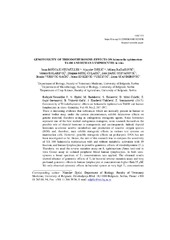Приказ основних података о документу
Genotoxicity of triiodothyronine: effects on salmonella typhimurium ta100 and human lymphocytes in vitro
| dc.creator | Bosnjak-Neumuller, Jasna | |
| dc.creator | Djelić, Ninoslav | |
| dc.creator | Radaković, Milena | |
| dc.creator | Kolarević, Stoimir | |
| dc.creator | Mitić-Culafić, Dragana | |
| dc.creator | Dajić-Stevanović, Zora | |
| dc.creator | Vuković-Gačić, Branka | |
| dc.creator | Knežević-Vukčević, Jelena | |
| dc.creator | Stanimirović, Zoran | |
| dc.date.accessioned | 2020-12-17T21:57:57Z | |
| dc.date.available | 2020-12-17T21:57:57Z | |
| dc.date.issued | 2017 | |
| dc.identifier.issn | 0534-0012 | |
| dc.identifier.uri | http://aspace.agrif.bg.ac.rs/handle/123456789/4409 | |
| dc.description.abstract | There is increasing evidence that substances which are normally present in human or animal bodies may, under the certain circumstances, exhibit deleterious effects on genetic material, therefore acting as endogenous mutagenic agents. Since hormones represent one of the best studied endogenous mutagens, some research focused on the possible role of thyroid hormone in mutagenesis and carcinogenesis. Indeed, thyroid hormones accelerate aerobic metabolism and production of reactive oxygen species (ROS) and, therefore, may exhibit mutagenic effects in various test systems on mammalian cells. However, possible mutagenic effects on prokaryotic DNA has not been investigated so far. Hence, the aim of this research was to compare the sensitivity of TA 100 Salmonella typhimurium with and without metabolic activation with S9 fraction, and human lymphocytes to possible genotoxic effects of triiodothyronine (T-3). Therefore, we used the reverse mutation assay on S. typhimurium (Ames test) and in vitro Comet assay in isolated peripheral blood human lymphocytes. In both tests-systems a broad spectrum of T-3 concentrations was applied. The obtained results showed absence of genotoxic effects of T-3 in bacterial reverse mutation assay and very profound genotoxic effects in human lymphocytes at concentrations higher than 15 mu M. We only observed cytotoxic effects in bacterial system at very high T-3 concentrations (300 and 500 mu M). In conclusion, T-3 was unable to increase the level of reverse mutations in Ames test both with and without S9 mix. Therefore, it seems that ROS production in mitochondria may be the primary cause of DNA damage caused by T-3 in mammalian cells. | en |
| dc.publisher | Društvo genetičara Srbije, Beograd | |
| dc.relation | info:eu-repo/grantAgreement/MESTD/Integrated and Interdisciplinary Research (IIR or III)/46002/RS// | |
| dc.rights | openAccess | |
| dc.rights.uri | https://creativecommons.org/licenses/by-nc-nd/4.0/ | |
| dc.source | Genetika | |
| dc.subject | Comet assay | en |
| dc.subject | DNA damage | en |
| dc.subject | human lymphocytes | en |
| dc.subject | triiodothyronine | en |
| dc.subject | TA100 Salmonella typhimurium | en |
| dc.title | Genotoxicity of triiodothyronine: effects on salmonella typhimurium ta100 and human lymphocytes in vitro | en |
| dc.type | article | |
| dc.rights.license | BY-NC-ND | |
| dc.citation.epage | 397 | |
| dc.citation.issue | 2 | |
| dc.citation.other | 49(2): 387-397 | |
| dc.citation.rank | M23 | |
| dc.citation.spage | 387 | |
| dc.citation.volume | 49 | |
| dc.identifier.doi | 10.2298/GENSR1702387B | |
| dc.identifier.fulltext | http://aspace.agrif.bg.ac.rs/bitstream/id/2955/4406.pdf | |
| dc.identifier.scopus | 2-s2.0-85033578412 | |
| dc.identifier.wos | 000418533000002 | |
| dc.type.version | publishedVersion |


